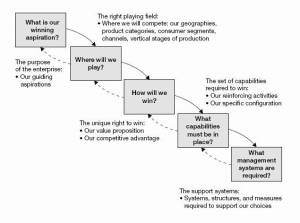“Playing to Win” is a book by A.G. Lafley and Roger L. Martin about “How Strategy Really Works” and it describes a model, the Strategic Choice Cascade, developed by the authors at P&G.
This model leads to the following “five strategic questions that create and sustain lasting competitive advantage”:
- Have you defined winning, and are you crystal clear about your winning aspiration?
- Have you decided where you can play to win (and just as decisively where you will not play)?
- Have you determined how, specifically, you will win where you choose to play?
- Have you pinpointed and built your core capabilities in such a way that they enable your where-to-play and how-to-win choices?
- Do your management systems and key measures support your other four strategic choices?
While there isn’t a direct fit between these questions and my X-Matrix TASTE model, I believe there is enough of an overlap for the model and the questions to be useful.
Lets look at them one by one:
Have you defined winning, and are you crystal clear about your winning aspiration?
Defining winning, and in particular winning aspirations is the most obvious fit with the X-Matrix Aspirations. In fact its possible that my choice of the word aspiration was influenced by Playing to Win. I confess I started reading the book some time ago, but I can’t remember exactly how long!
Have you decided where you can play to win (and just as decisively where you will not play)?
Deciding where to play to win links primarily to the X-Matrix Strategies, especially with Strategy being about decisions and choices, and hence also deciding where not to play.
Have you determined how, specifically, you will win where you choose to play?
The specificity of determining how to win, feels like a link to the X-Matrix Tactics, although I think there is still something strategic about “how” as opposed to “what”.
Have you pinpointed and built your core capabilities in such a way that they enable your where-to-play and how-to-win choices?
Building core capabilities can be considered to be X-Matrix Tactics, especially if we consider determining how to win to be more strategic. On the other hand, I also often describe the development of capabilities as providing X-Matrix Evidence of progress towards Aspirations.
Do your management systems and key measures support your other four strategic choices?
The key measures to support the other choices will also support the X-Matrix elements and correlations, and thus provide Evidence of progress towards Aspirations. Additionally, the management systems the book describes, emphasising assertive enquiry, closely resembles Catchball and the sort of collaboration I would expect Strategy Deployment to demonstrate.
My conclusion, therefore, is that the approach described in Playing to Win, with its Strategic Choice Cascade (and associated Strategy Logic Flow) can be considered to be another form of Strategy Deployment – a form of organisational improvement in which solutions emerge from the people closest to the problem. The early questions in the cascade focus on the problem, and the later questions focus on the emergence of the solutions.
As a result, when considering Agility as a Strategy, reflect on the above 5 strategic questions for your Agile Transformation to create alignment around how Agile helps you Play to Win?


[…] Strategy Deployment and Playing to Win (Karl Scotland) […]